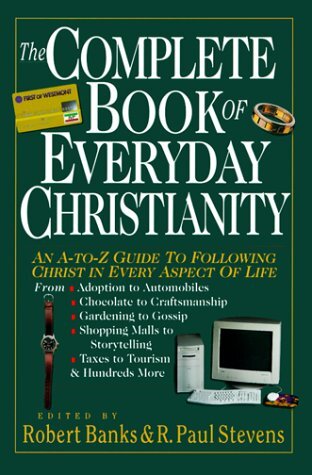Church Renewal
Book / Produced by partner of TOW
Renewal is difficult to define. It can mean different things to different people. Even the dictionary suggests several options, from “restore to original state” (as in a painting) to “replenish with a fresh supply” (as in recharging a dead battery). Church renewal has encompassed both of the above, that is, a desire by churches to rediscover the life and form of the early church and to restore its “Pentecostal” power.
Ecclesiastical and Charismatic Renewal
In England the late David Watson (I Believe in the Church) and in North America Howard Snyder (Community of the King) are but two authors among many who have tried to share a vision of church life that is more vital and effective. This ecclesiological emphasis on renewal stressed the priesthood and giftedness of all believers and that the role of church leadership was to equip God’s people to do the ministries so long designated as “clergy” roles (Ephes. 4:11-16; see Stevens).
Alongside of, and vital to, ecclesiological renewal has been the charismatic movement. Controversial, multifaceted and at times schismatic, it has nevertheless brought new life to most denominations. Not all charismatics have exactly the same theology. Some believe that the baptism of the Holy Spirit (accompanied by the gift of tongues) is a distinct and special experience that launches a believer into a new life of power and spiritual giftedness. Others, while strongly affirming that all the gifts of the Spirit exist today, do not believe that the baptism in the Spirit is a special (or second) work of grace. They believe that the command to be filled with the Spirit (Ephes. 5:18) is given to God’s community as the norm that establishes the full operation of all of the Holy Spirit’s gifts in the church. In the early 1960s the charismatic movement (what some call the “renewal in the Spirit”) was in full force. In the United Kingdom Colin Urquhart’s When the Spirit Comes and in North America Dennis Bennett’s Nine O’Clock in the Morning were early editions of scores of books, Catholic and Protestant, explaining what some have called neo-Pentecostalism.
The marriage of both the ecclesiological and the pneumatological has been typical of most churches that declare they are being renewed. For a good theological analysis of this blend, read J. I. Packer’s Keep in Step with the Spirit.
Renewal and Small Groups
In Britain this duality was seen in the so-called house church movement. Some Christians took on radical anti-institutional church positions at first, but by and large they were believers experiencing the new wine (the power of the Spirit) in new wineskins (simpler New Testament forms). Many mainline churches in England, particularly Anglican and Baptist, took on much of the ethos of the house churches while remaining within and loyal to their denominations. There was an emphasis on the three C’s: cell, congregation, celebration. This means that the primary unit of life in a church is the small cell, consisting of about a dozen people who meet weekly for worship, study, fellowship and outreach. A number of cells come together periodically to form a congregation, when the same experiences on a broader scale can be expressed. They can meet geographically in an area of a town and be more localized in their ministries than the church at large meeting in a regular church building. The celebration is the meeting of all the cells for praise, worship and public teaching. ICTHUS Fellowship of London, led by Roger Forster and Graham Kendrick (who writes many of Britain’s renewal songs), is among the most well-known expressions of this renewal.
The largest church in the world, the Oida Full Gospel Church of Seoul, South Korea, led by David Yonggi Cho, has attained phenomenal statistical growth through its emphasis on the role of cells, that basic concept that has been championed by Ralph Neighbour in his book on the cell church, Where Do We Go from Here?
The cell-church model differs from the North American metachurch model advocated by Carl George, which encourages many kinds of cells and interest groups within a church that also has many programs. The “pure” cell-church model emphasizes that the cell is the church and that by intentional evangelism it will keep growing and multiplying. Most cell churches have some form of the three C’s.
In North America and elsewhere, the Vineyard churches (whose chief early leader was John Wimber) are similar and have brought to the fore an emphasis on the church displaying the power of God’s kingdom in our society (read Power Healing and Power Evangelism by Wimber and Springer).
An early model of renewal in North America was the Church of the Savior in Washington, D.C. (clearly explained by E. O’Connor in Call to Commitment). In what has been called a post-Christian and postmodern time, this model of church renewal, while contrary to the present trend of megachurches, may yet prove to be one of the most feasible and effective as we enter the twenty-first century. Its emphasis on mission groups (cells) and high commitment to community life (though not monastic), which is mobilized to affect the world with care and evangelism, is highly relevant and suggestive.
Renewal, Revival and Evangelism
Contemporary renewal movements are similar to earlier ones, for example, to John Wesley’s emphasis on the class meeting (cells) and bands (mission groups). Each renewal also brings a fresh emphasis on music and worship with new and simple songs in the popular idiom of the day.
Historically, renewals have seen a fresh emphasis on evangelism. This was not at first true of the current renewal, but now it is becoming a major aspect among all churches. Many not in the charismatic movement have found renewal in churches through evangelism and have realized that reaching out to others with the gospel was at the heart of the first Pentecostal visitation (Acts 1:8). Leaders such as Bill Hybels of Willow Creek Community Church near Chicago have invited us all to contextualize our gospel and find effective means of growth in order to reach unchurched peoples; seeker-sensitive services are but one aspect of a growing renewal in evangelism.
Renewal is seen by some as the forerunner to revival—getting the church back on track so that God can bless it fully. Renewal is not revival, but it carries the seeds of revival, especially as such renewal relies on God’s Spirit to produce by his power what our human effort cannot. Renewing churches rediscover prayer, particularly intercessory prayer, so they can do warfare against dark principalities and powers. Members of renewing churches will be sensitive to the presence of God’s Spirit in all aspects of their lives, and empowered by the Spirit, they will express and demonstrate the power of the gospel through reaching out to those without Christ. Renewal without evangelism is simply not renewal but self-centered indulgence in quasi-spiritual things.
No church can say it is renewed but rather that it is being renewed. But the process has begun with the confession of need, both personal and corporate, as expressed in the ancient prayer “Lord, revive your church, beginning with me.”
» See also: Church in the Home
» See also: Evangelism
» See also: Small Groups
References and Resources
D. J. Bennett, Nine O’Clock in the Morning (Plainfield, N.J.: Logos International, 1970); R. Neighbour Jr. and L. Jenkins, Where Do We Go from Here? A Guidebook for Cell Group Churches (Houston: Touch, 1990); E. O’Connor, Call to Commitment: The Story of the Church of the Savior (New York: Harper & Row, 1963); H. A. Snyder, The Community of the King (Downers Grove, Ill.: InterVarsity Press, 1977); H. A. Snyder, Signs of the Spirit: How God Reshapes the Church (Grand Rapids: Zondervan, 1989); R. P. Stevens, Liberating the Laity (Downers Grove, Ill.: InterVarsity Press, 1985); C. Urquhart, When the Spirit Comes (London: Hodder & Stoughton, 1979); D. C. K. Watson, I Believe in the Church (Grand Rapids: Eerdmans, 1979); J. Wimber and K. Springer, Power Evangelism (San Francisco: Harper & Row, 1986); J. Wimber and K. Springer, Power Healing (San Francisco: Harper & Row, 1987).
—Bob Roxburgh





